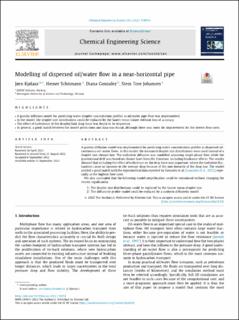| dc.contributor.author | Kjølaas, Jørn | |
| dc.contributor.author | Schümann, Heiner | |
| dc.contributor.author | Gonzalez Rengifo, Diana Carolina | |
| dc.contributor.author | Johansen, Stein Tore | |
| dc.date.accessioned | 2022-09-30T08:02:50Z | |
| dc.date.available | 2022-09-30T08:02:50Z | |
| dc.date.created | 2022-09-15T20:31:57Z | |
| dc.date.issued | 2022 | |
| dc.identifier.citation | Chemical Engineering Science (CES). 2022, 263, 1-18. | en_US |
| dc.identifier.issn | 0009-2509 | |
| dc.identifier.uri | https://hdl.handle.net/11250/3022725 | |
| dc.description.abstract | A gravity-diffusion model was implemented for predicting water concentration profiles in dispersed oil-continuous oil–water flows. In this model, the measured droplet size distributions were used instead of a droplet size closure law. The turbulent diffusion was modelled assuming single-phase flow while the gravitational drift was based on closure laws from the literature, including hindrance effects. The results showed that including the effect of turbulence on the drag force was important, where the turbulent fluctuations cause an increase in the average drag because of the non-linearity of the drag law. The model yielded a good match with the experimental data reported by Gonzales et al. (Gonzalez et al., 2022), especially at the highest flow rates. We also concluded that the following model simplification could be introduced without changing the results significantly: 1) The droplet size distributions could be replaced by the Sauter mean droplet size. 2) The diffusivity profile model could be replaced by a uniform diffusivity model. | en_US |
| dc.language.iso | eng | en_US |
| dc.publisher | Elsevier | en_US |
| dc.rights | Navngivelse 4.0 Internasjonal | * |
| dc.rights.uri | http://creativecommons.org/licenses/by/4.0/deed.no | * |
| dc.title | Modelling of dispersed oil/water flow in a near-horizontal pipe | en_US |
| dc.title.alternative | Modelling of dispersed oil/water flow in a near-horizontal pipe | en_US |
| dc.type | Peer reviewed | en_US |
| dc.type | Journal article | en_US |
| dc.description.version | publishedVersion | en_US |
| dc.rights.holder | Copyright: 2022 The Author(s). Published by Elsevier Ltd. | en_US |
| dc.source.pagenumber | 18 | en_US |
| dc.source.volume | 263 | en_US |
| dc.source.journal | Chemical Engineering Science (CES) | en_US |
| dc.identifier.doi | 10.1016/j.ces.2022.118074 | |
| dc.identifier.cristin | 2052224 | |
| dc.relation.project | Norges forskningsråd: 295035 | en_US |
| dc.source.articlenumber | 118074 | en_US |
| cristin.ispublished | true | |
| cristin.fulltext | original | |
| cristin.qualitycode | 2 | |

